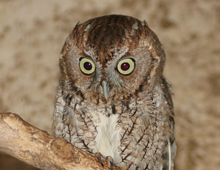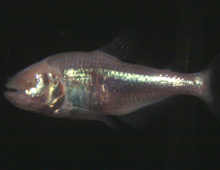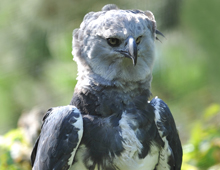Mundo Maya

Seba’s short-tailed bat, Carollia perspicillata
In zoos, colonies of this species are like yeast — a few sent to another zoo soon reproduce to the carrying capacity of their exhibit, and more colonies can be established from there. From a few importations more than 30 years ago, there are now more than 6,000 of these fruit-eating bats distributed among more than 30 North American collections. This is a widespread species, found from Mexico to Paraguay. In the Mayan epic, the Popol Vuh, a bat, Zotz, stole the head of the Hero God Hunahpu for the Gods of the Underworld to use in a ballgame.
LEARN MORE
Eastern screech owl, Megascops asio
Instead of a screech, this bird actually produces a rather gentle-sounding descending trill. Being small, it is prone to being eaten by other owls. On the other hand, they are not much disturbed by human activities, and are common in suburbs. Normally nesting in holes in trees, they readily use man-made sites, including all sorts of abandoned structures. This leads to the frequent discovery of young birds by demolition teams and home-owners that turn them over to rehabilitators, thus making them very common in zoos and nature centers.
LEARN MORE
Blind cavefish, Astyanax fasciatus mexicanus
When first discovered in the 1930s, these eyeless, pigmentless fish were assigned their own genus, Anoptichthys. Since then, ichthyologists have determined they are at least 30 genetically isolated populations of the Mexican tetra, which is normally a silvery fish with well-developed eyes that is found north to the Rio Grande Valley in Texas. Fish collected in one cave, la Cueva Chica, in San Luis Potosi in the 1940s, are the ancestors of the fishes made available by commercial breeders to home aquarists, public aquariums and zoos.
LEARN MORE
Keel-billed toucan, Ramphastos sulfuratus
Also known as the Rainbow-billed or Sulfur-breasted toucan, it is popular for its resemblance to “Toucan Sam™”, the “Froot Loops®” mascot. The northernmost of the large toucans, it ranges from the Mexican state of San Louis Potosi south to Colombia and Venezuela. Much habitat has been lost to agriculture. Though first hatched in captivity at the Houston Zoo, in 1974, it has not bred consistently in collections. The DWA is involved in a captive breeding consortium for this species involving both private collections and public zoos.
LEARN MORE
Quetzals, Pharomachrus
The Mayans and Aztecs demanded rare tribute from their subject peoples. The feathers of quetzals were prized more than gold. The five species of quetzals are specialized trogons, found from Mexico south to Bolivia and Brazil. The three species that are part of the collection at the DWA are: Golden-headed quetzal (Pharomachrus auriceps), Crested quetzal (Pharomachrus antisianus) and the Resplendent quetzal (Pharomachrus mocinno). All are green and red, but only the Resplendent quetzal, of Mexico and Central America, bears the prized long plumes.
LEARN MORE
Harpy eagle, Harpia harpyja
A top-of-the-food chain predator, this enormous bird is not abundant anywhere in its vast range from the Mexican States of Veracruz and Oaxaca south to Argentina, Bolivia, and Southern Brazil. A specialist in eating sloths and monkeys, it depends on extensive forest, so is considered Near-Threatened due to habitat loss. Females may exceed 20 pounds in weight. Probably kept by Montezuma, it was displayed in Europe as early as 1778. The first successful captive breeding did not occur until 1981. The female displayed at the DWA hatched at the San Diego Zoo.
LEARN MORE
Scarlet macaw, Ara macao
This marvelous parrot was one of the first New World animals brought alive to Europe, in the 1500s. Long before, it was prized as a pet, and for its feathers, by many Native American cultures. Live birds were traded to Arizona and New Mexico from Mexico for more than 700 years. Known as Mo to the Mayans, it was revered by their Kings, some of who wore rubber rings on their faces in honor of it. Threatened in Mexico and Central America, it remains common in much of South America. First hatched in the US in 1916, it breeds well in captivity.
LEARN MORE
Purple-throated fruitcrow, Querula purpurata
Despite their name, the several species of fruitcrows are not related to crows at all, though they do eat many kinds of fruit, which they gather both while in flight and perching in trees. Like many other members of the cotinga family, the males have a distinctive display, courting the all black females by flaring out their brilliant throat feathers (which can appear bright red), shaking their tails back and forth and making piercing calls. A relative of the Cock-of-the-rock, this species has only rarely been kept in captivity, despite being found over a vast area of South America, as well as Costa Rica and Panama. It was not bred in a zoo until 2006, when the Wuppertal Zoo in Germany was successful.
LEARN MORE
Red-legged honeycreeper, Cyanerpes cyaneus
Honeycreepers are tanagers adapted to drinking nectar, and are sometimes mistaken for hummingbirds due to their slender beaks and continual busyness. Found from Mexico to Southern Brazil, for decades this species has been popular in zoos and private aviaries where they have been bred for more than 60 years. Unusual among tanagers, males molt out their brilliant blue and black pattern for part of the year, resembling the streaky green females. Both have bright yellow feathers concealed under their wings that are visible when in flight.
LEARN MORE
Blue dacnis, Dacnis cayana
The nine species of Dacnis are specialized small tanagers that hunt for insects, eat berries and drink nectar. While some of them are rare, the Blue dacnis has an enormous distribution across South America, as well as southern Central America. It is a common species in zoos, and has been known as cage bird for more than a hundred years. While only the males have the bright blue and black pattern, females are also brilliantly colored, in bright greens and blues.
LEARN MORE

